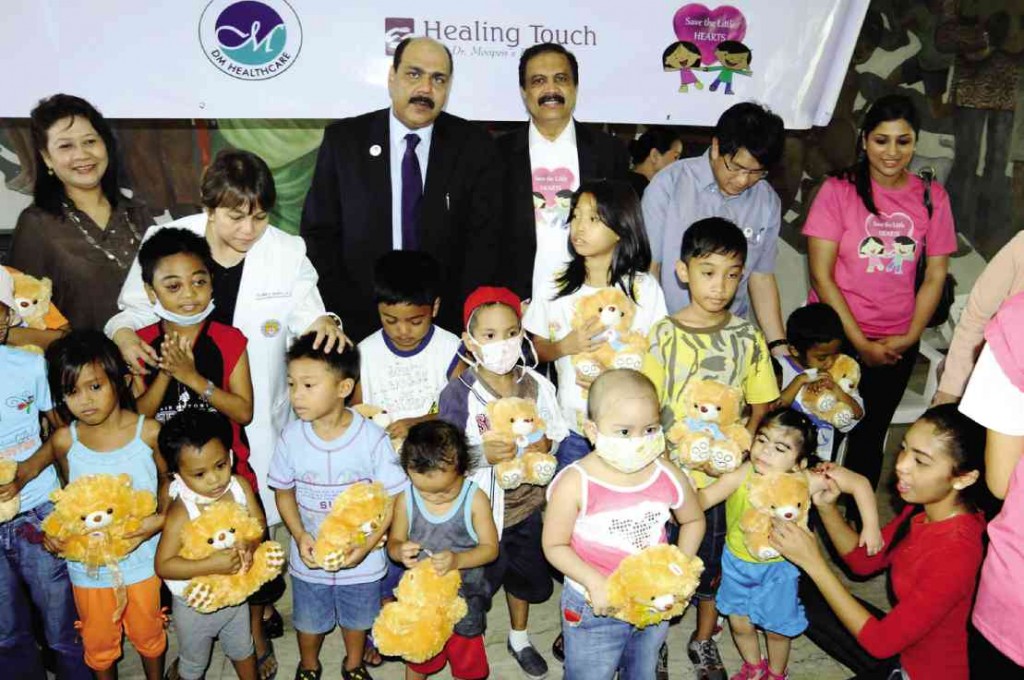
MOOPEN (back, wearing coat over a collared shirt with the Save the Little Hearts logo) visited the Philippines in 2013 to oversee the launch of a program to help for free, poor children with congenital heart defect.
While billionaires like Bill Gates ($79.2 billion), Carlos Slim Helu ($77.1 billion) and Warren Buffett ($72.7 billion) are known for their philanthropy, by one measure Dr. Azad Moopen could be considered even more generous: he sets aside 20 percent of his income—which is currently at $1.46 billion—for philanthropy every year.
That huge amount mostly goes to Dr. Moopen’s Foundation (DM Foundation), a charitable and corporate social responsibility division of DM Healthcare, a leading healthcare conglomerate in the Gulf Cooperation Council (Saudi Arabia, Kuwait, the United Arab Emirates, Qatar, Bahrain and Oman) and India (where Moopen was born).
“Aside from being very active in the Gulf countries and across India, the foundation is also present in the Philippines where, for years, has been involved in various health awareness campaigns and philanthropic activities in line with its ‘Healing Touch’ initiative,” said Joyce Socao-Alumno, country manager of Aster DM Healthcare.
Cardiac surgery for kids
Alumno said that while its not-for-profit activities include the establishment of community dialysis centers, cancer radiation centers and early cancer detection centers, free pediatric and adult cardiac surgeries, and establishment of special needs schools for the physically and mentally challenged across Kerala (a state in Southern India and where Moopen was born), the foundation here in the Philippines is still concentrating on the “Save The Little Hearts” program, where it has provided free pediatric cardiac surgery to children since 2013.
Alumno said: “‘Save The Little Hearts’ program is the foundation’s first charity initiative in the Philippines because we believe pediatric cardiology is a critical area of medical care that is sorely needed by a lot of underprivileged children here. From here, the foundation plans to extend its not-for-profit activities, which are all aimed at promoting overall wellness in the Philippines.”
She explained that working here would not be too hard for the foundation as it has already teamed up with a number of government hospitals since 2013, particularly in the selection of young patients with heart diseases based on their critical need for treatment.
While surgeries that can be treated within the Philippines were carried out under complete supervision and funding by the foundation, Alumno said the foundation could also send a patient with a more complicated case to India, where a comprehensive medical care at a hospital under the Aster DM Healthcare network will be provided.
Alumno said: “The foundation-affiliated hospitals in India are very advanced. It is interesting to note that a 10-year-old Filipino now based in Dubai became a recent recipient of the foundation. He suffers from Tetralogy of Fallot—a rare and life-threatening congenital heart defect that does not let enough blood enter the lungs and absorb enough oxygen. Even walking a few steps was an arduous task as his oxygen levels would drop and would faint. He was flown to Aster Medcity in Kochi, Kerala, where one of the most complex and specialized procedures in pediatric cardiac surgery was successfully performed.”
Very close
She added that Filipinos are very close to Moopen’s heart considering that Aster DM Healthcare, where he is chair and managing director, is staffed by so many Filipinos (mostly nurses) and that he wanted to give something back to the community that is integral to his company’s growth.
Present primarily in the Gulf Cooperating Council region and Jordan, the healthcare conglomerate will soon enter the Philippines with the intention of becoming one of the most used and recognizable health providers in the country.
Established in 1987 by Moopen, Aster DM Healthcare has expanded from a collection of small clinics to an expansive empire, comprising of clinics, hospitals and pharmacies as well as research facilities, educational institutions, beauty clinics.
Today, the group employs more than 13,500, including 1,500 doctors, and provides 4,000 patient beds across 16 hospitals.
Alumno concluded: “As a doctor, Moopen used to see close to 100 patients a day but he knew as a single practitioner, this was all he could attend to. What he did later was to reach out to more like-minded professionals who believe in making a difference to the people they serve. Soon he was able to create a system whose primary intention is to ensure the best care for the patients, an organization that believes very vehemently that in healthcare, profit should only be a by-product but never the aim.”